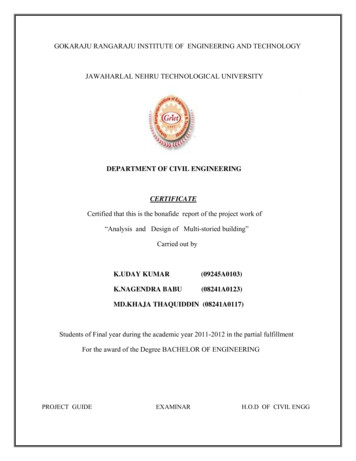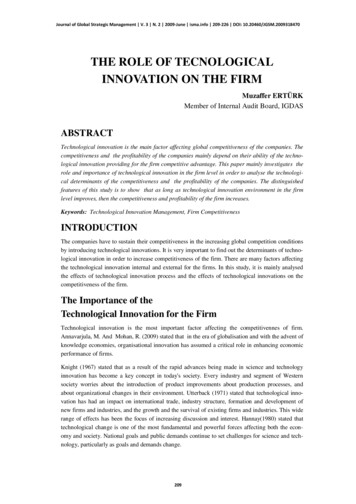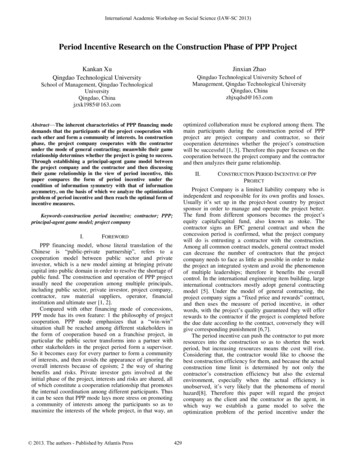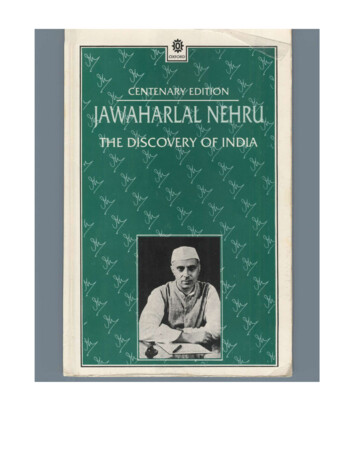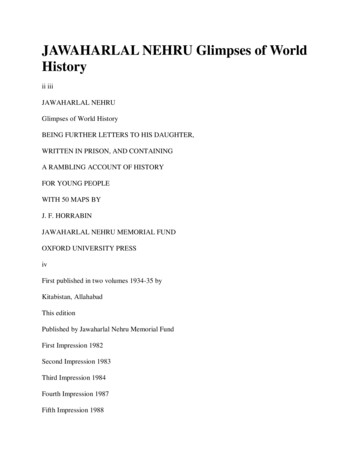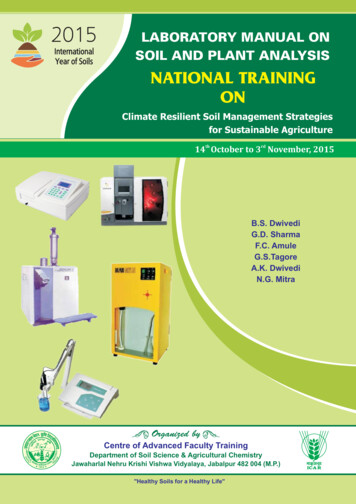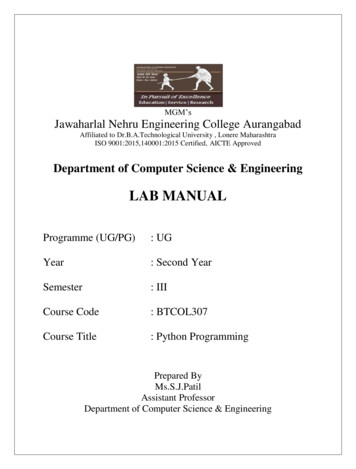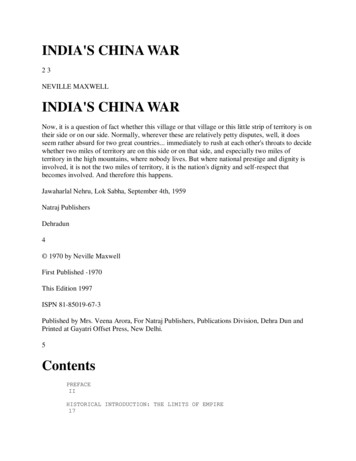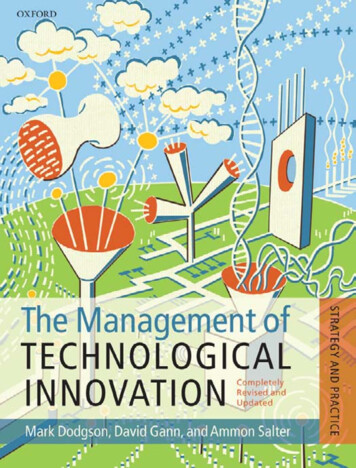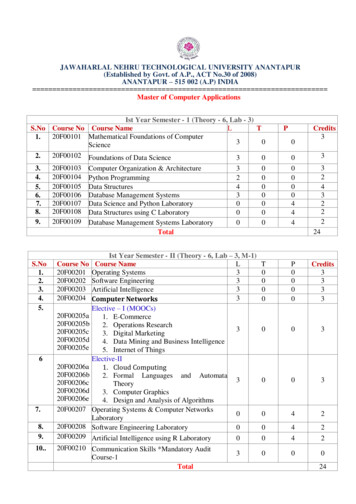
Transcription
JAWAHARLAL NEHRU TECHNOLOGICAL UNIVERSITY ANANTAPUR(Established by Govt. of A.P., ACT No.30 of 2008)ANANTAPUR – 515 002 (A.P) INDIA Master of Computer ApplicationsIst Year Semester - 1 (Theory - 6, Lab - 3)S.No Course No Course 0Science20F00102 Foundations of Data Science2.3020F00103 Computer Organization & Architecture3.3020F00104 Python Programming4.2020F00105 Data Structures405.20F00106 Database Management Systems306.20F00107 Data Science and Python Laboratory7.0020F00108 Data Structures using C Laboratory8.0020F00109 Database Management Systems Laboratory9.00Total24S.No1.2.3.4.5.Course 20F00209Ist Year Semester - II (Theory - 6, Lab – 3, M-1)Course NameLOperating Systems3Software Engineering33Artificial Intelligence3Computer NetworksElective – I (MOOCs)1. E-Commerce2. Operations Research33. Digital Marketing4. Data Mining and Business Intelligence5. Internet of ThingsElective-II1. Cloud Computing2. Formal Languages and Automata3Theory3. Computer Graphics4. Design and Analysis of Algorithms5. mputer Networks0LaboratorySoftware Engineering Laboratory0Artificial Intelligence using R Laboratory020F00210 Communication Skills *Mandatory 00P0000Credits333300300304200442200024
II year Semester - 1 (Theory - 6, , Lab – 3, M-1)S.No Course No Course NameL20F00301 Web & OOA 0920F00310Big Data AnalyticsDev Ops & Agile ProgrammingElective – III1. Software Architecture & DesignPatterns2. Cyber Security3. Multimedia Systems & Tools4. Machine Learning5. Compiler DesignElective-IV1. Software Project Management2. Wireless Sensor Networks3. Service Oriented Architecture4. Deep Learning5. Android ProgrammingElective-V1. Software Quality Assurance & Testing2. Block Chain Technologies3. Augmented Reality/Virtual Reality4. Natural Language Processing5. Mobile Application DevelopmentWeb & OOA Design using Java LaboratoryBig Data Analytics LaboratoryDev Ops & Agile Programming LaboratoryUniversal Human Values *Mandatory 44422230003TotalII year Semester - I1 (Project & Comprehensive Viva))S.No Course NoCourse Name20F00401 Project work1.20F00402 Comprehensive Viva-Voce2.24C16218
JAWAHARLAL NEHRU TECHNOLOGICAL UNIVERSITY ANANTAPURMCA– I SemL T P C3 0 0 3(20F00101) MATHEMATICAL FOUNDATIONS OF COMPUTER SCIENCECourse Objectives To explain about the Boolean Algebra, Graph theory and Recurrence relations.To demonstrate the application of basic methods of discrete mathematics in Computer Scienceproblem solving.To elucidate solving mathematical problems from algorithmic perspective.To introduce the mathematical concepts which will be useful to study advanced courses Designand Analysis of Algorithms, Theory of Computation, Cryptography and Software Engineeringetc.UNIT- IStatements and Notation, Connectives- Negation, Conjunction, Disjunction, Conditional and Biconditional, Statement formulas and Truth Tables. Well-formed formulas, Tautologies, Equivalence ofFormulas, Duality Law, Tautological Implications.Normal Forms: Disjunctive Normal Forms, Conjunctive Normal Forms, Principal DisjunctiveNormal Forms (PDNF), Principal Conjunctive Normal Forms (PCNF), Ordering and Uniqueness ofNormal Forms.The Theory of Inference for the Statement Calculus: Rules of Inference, Consistency of Premisesand Indirect Method of Proof.The predicate Calculus, Inference theory of the Predicate Calculus.Learning Outcomes:At the end of this unit, the student will be able to Describe logical sentences in terms of predicates, quantifiers, and logical connectives (L1)Evaluate basic logic statements using truth tables and the properties of logic (L5).Apply rules of inference to test the consistency of premises and validity of arguments (L3).Verify the equivalence of two formulas and their duals (L4).Find the Principal Conjunctive and Principal Disjunctive Normal Forms of a statement formula(L1).UNIT-IISet Theory: Basic concepts of Set Theory, Representation of Discrete structures, Relations andOrdering, Functions, Recursion.Lattices and Boolean Algebra: Lattices as Partially Ordered Sets, Partial order relation, poset Lattices, Hasse diagram, Boolean Functions, Representation and Minimization of Boolean Functions.Learning Outcomes:At the end of this unit, the student will be able to Describe equivalence, partial order and compatible relations (L1).Compute Maximal Compatibility Blocks (L3).Identify the properties of Lattices (L2).
Evaluate Boolean functions and simplify expression using the properties of Boolean algebra(L5).UNIT-IIIAlgebraic Structures: Semi group - Monoid – Groups, Cyclic group - Permutation group(Sn and Dn)- Substructures - Homomorphism of semi group, monoid and groups - Cosets and Lagrange Theorem– Normal Subgroups - Rings and Fields (Definition and examples only)Learning Outcomes:At the end of this unit, the student will be able to Infer Homomorphism and Isomorphism (L4).Describe the properties of Semi groups, Monoids and Groups (L1).Describe the properties Normal subgroups.Describe the properties Rings and Fields.UNIT-IVElementary Combinatorics: Basics of Counting, Combinations and Permutations, Enumeration ofCombinations and Permutations, Enumerating Combinations and Permutations with repetitions,Enumerating Permutations and Combinations with constrained Representations, BinomialCoefficients, The Binomial and Multinomial Theorems, The Principle of Inclusion and Exclusion.Learning Outcomes:At the end of this unit, the student will be able to Explain fundamental principle of counting (L2).Examine the relation between permutation and combination (L4).Solve counting problems by applying elementary counting techniques using the product andsum rules (L3).Apply permutations, combinations, the pigeon-hole principle, and binomial expansion to solvecounting problems (L3).UNIT-V:Recurrence Relations: Generating Functions of Sequences, Calculating Coefficients of GeneratingFunctions, Recurrence Relations, Solving Recurrence Relations by Substitution and GeneratingFunctions, The method of Characteristic Roots, Solution of Inhomogeneous Recurrence Relations.Learning Outcomes:At the end of this unit, the student will be able to Find the generating functions for a sequence (L1).Design recurrence relations using the divide-and-conquer algorithm (L6).
Solve linear recurrence relations using method of Characteristic Roots (L3).Outline the general solution of homogeneous or Inhomogeneous Recurrence Relationsusing substitution and method of generating functions (L2).Solve problems using recurrence relations and recursion to analyze complexity of algorithms(L3).After completion of this course the student would be able to Evaluate elementary mathematical arguments and identify fallacious reasoning (L5). Understand the properties of Compatibility, Equivalence and Partial Ordering relations,Lattices and Has see Diagrams (L1). Understand the general properties of Algebric Systems, Semi Groups, Monoids,Groups (L1),Normal subgroups,Rings and Fields Design solutions for problems using breadth first and depth first search techniques (L6) Solve the homogeneous and non-homogeneous recurrence relations (L3).Text Books:1. Joe L. Mott. Abraham Kandel and Theodore P. Baker, “Discrete Mathematics for ComputerScientists & Mathematicians”, 2nd Edition, Pearson, 2008. (for Units III to V).2. J P Trembly and R Manohar, “Discrete Mathematical Structures with Applications toComputer Science”, 1st Edition, McGraw Hill, 2017(For Unit I&II).Reference Books:1. Ralph P. Grimaldi and B.V. Ramana, “Discrete and Combinatorial Mathematics, an AppliedIntroduction”, 5th Edition, Pearson, 2016.2. Narsingh Deo, “Graph Theory with Applications to Engineering”, Prentice Hall, 1979.3. D.S. Malik and M.K. Sen, “Discrete Mathematics theory and Applications”, Ist Edition,Cenegage Learning, 2012.4. C L Liu and D P Mohapatra, “Elements of Discrete Mathematics, A computer Orientedapproach”, 4th edition, MCGRAW-HILL, 2018.
JAWAHARLAL NEHRU TECHNOLOGICAL UNIVERSITY ANANTAPURMCA– I SemL T P C3 0 0 3(20F00102) FOUNDATIONS OF DATA SCIENCECourse ObjectivesIdeally for a student to understand Data Science, he/she should have exposure to the following. Thiswill give a basic feel about Data Science. In the following, the topics highlighted in light blue isminimum needed and those highlighted in yellow will help to get a feel about the subject.Overall it covers the following: Basics of probabilityBasics of statisticsPattern RecognitionMachine LearningIntroduction on Deep Neural Networks.UNIT-IIntroduction to Probability and Statistics:Descriptive Statistics: Measures of central tendency—mean, median, mode, harmonic mean andgeometric mean; Measures of dispersion – mean deviation from mean, standard deviation andvariance. Central moments.Linear and rank correlation. Covariance and correlation; Statistics andsampling distributions; Hypothesis testing of means, proportions, variances and correlations Definitionof random variable and probability, (problems depending on counting –taught in MFCS), discreteprobability distributions: Bernoulli, Binomial, Poisson; Continuous probability distributions:Gaussian, Exponential, Chisquare. Definition of Bayesian probability.Probability theory and axioms; Random variables; Probability distributions and density functions(univariate and multivariate); Expectations and moments;; Confidence (statistical) intervals;Correlation functions; White-noise process. Probability, Hypothesis and Inference, Gradient Descent.Learning Outcomes:At the end of this unit, the student will be able to Understand how to summarise data through measures of central tendency, dispersion, momentsand correlation.Understand random variable and associated probability distributionsIt lays foundations for further UNITs.UNITT-IIExploratory Data Analysis (EDA), Data Science life cycle, Descriptive Statistics, Basic tools (plots,graphs and summary statistics) of EDA, Philosophy of EDA.
Data Visualization: Scatter plot, bar chart, histogram, boxplot, heat maps etc.Learning Outcomes:At the end of this unit, the student will be able to Learn to analyse the data through plotting: from raw-scatter plot to summarized visualization.Understand the functionality of various phases of data Science.Analyze the characteristics of dataUNIT-IIIIntroduction to Pattern Recognition and Machine LearningPatterns, features, patter representation, curse of dimensionality, dimensionality reduction. Supervisedand Unsupervised learning.Classification—linear and non-linear. Bayesian, Perceptron, Nearestneighbor classifier, Support vector machine, use of kernels, Logistic regression, Naïve-bayes, decisiontrees and random forests; boosting and bagging.Clustering---partitional and hierarchical; k-meansclustering.Regression.Least squares. Evaluation metrics: RMSE, MAE and Coefficient of Determination (Rsquare)Cost functions, training and testing a classifier. Cross-validation.Class-imbalance – ways of handling,Exploratory data analysis (EDA), evaluation metrics— Precision, Recall, RoC, AUC; Confusionmatrix, Classification accuracyLearning Outcomes:At the end of this unit, the student will be able to Understand the meaning of pattern, feature, importance of pattern representation.Classification methods, their working and evaluation.Minimising cost functionRegression and evaluation.Exploratory data analysis (outcome of Unit-I; can be tried out in the associated lab)UNIT-IVIntroduction to Deep LearningMultilayer perceptron.Back propagation. Loss functions. Epochs and Batch sizes.Hyper parametertuning.Applications to classification, regression and unsupervised learning.Overview(introduction tothe terms) of RNN, CNN and LSTM.Learning Outcomes:At the end of this unit, the student will be able to Understanding of deep neural networks as extension of multi-layer perceptronUnsupervised and supervised learning in deep neural networksUnderstand what is deep learningMinimizing loss functions
How a deep learning models are trainedFamiliarity of popular deep learning modelsUNIT-VOverview of Data Science Models.Applications to text, images, videos: recommender systems, image classification, Social networkgraphsLearning Outcomes:At the end of this unit, the student will be able to Applications of data science/machine learningFamiliarity of applicationsTextbooks:1. Cathy O’Neil, Rachel Schutt, Doing Data Science, Straight Talk from the Frontline. O’Reilly,2013.2. Christopher Bishop, Pattern Recognition and Machine Learning, Springer, 2007.3. Ian Goodfellow, YoshuaBengio, Aaron Courville, Deep Learning, MIT Press, 20164. Trevor Hastie, Robert Tibshirani, Jerome Friedman, The Elements of Statistical Learning,Springer 2009.5. Erwin kreyszig, Advanced Engineering Mathematics, 10th Edition, John Wiley & Sons,2011.References:1. Michael Nielsen, Neural Networks and Deep Learning, Determination Press, 2015.2. Francois Chollet, Deep Learning with Python, 1/e, Manning Publications Company, 20173. [UNIT-1] Robert V Hogg, Allen Craig and J.W. McKean. Introduction to MathematicalStatistics. Pearson. (Indian Edition)4. [UNIT-II] EMC2: 4) Data Science and Big Data Analytics, EMC Education Services, EMC 2 ,Wiley Publication, 2015.5. [UNIT-III] V. Susheela Devi and M. NarasimhaMurty. Pattern Recognition – An Introduction.Universities Press (Indian Edition; there is an expensive Springer version of the same)6. [UNIT-II] Christopher M. Bishop. Pattern Recognition and Machine Learning. Springer(Indian Edition)7. [UNIT-III]Ian Goodfellow and YoshuaBengio and Aaron Courville. Deep Learning. MITPress. Book available online at https://www.deeplearningbook.org/.8. [UNIT-IV] J. Leskovec, A. Rajaraman, J.D. Ullman. Mining of Massive Datasets. CambridgeUniversity Press. (Indian Edition; Online pdf is available for download)
JAWAHARLAL NEHRU TECHNOLOGICAL UNIVERSITY ANANTAPURMCA– I SemL T P C3 0 0 3(20F00103) COMPUTER ORGANIZATION & ARCHITECTURECourse Objectives: Learn the fundamentals of computer organization and its relevance to classical and modernproblems of computer designUnderstand the structure and behavior of various functional modules of a computer.Discuss the techniques that computers use to communicate with I/O devicesStudy the concepts of pipelining and the way it can speed up processing.Describe the basic characteristics of multiprocessorsUNIT - IBasic Structure of Computer: Computer Types, Functional Units, Basic operational Concepts, BusStructure, Software, Performance, Multiprocessors and Multicomputer.Machine Instructions and Programs: Numbers, Arithmetic Operations and Programs, Instructionsand Instruction Sequencing, Addressing Modes, Basic Input/output OperationsINTEL-8086: CPU architecture, Addressing modes - generation of physical address- code segmentregisters, Zero, one, two, and three address instructions. INTEL 8086 ASSEMBLY LANGUAGEINSTRUCTIONS-Data transfer instructions, input- output instructions, arithmetic, logical, shift, androtate instructions, Conditional and unconditional transfer.Learning Outcomes:At the end of this unit, the student will be able to Understand the basic functional units and the ways they are interconnected to form a computersystemIllustrate various addressing modes for accessing register and memory operandsDescribe the instruction sequencing and various types of instructionsUNIT - IIArithmetic: Addition and Subtraction of Signed Numbers, Design of Fast Adders, Multiplication ofPositive Numbers, Signed-operand Multiplication, Fast Multiplication, Integer Division, FloatingPoint Numbers and Operations.Basic Processing Unit: Fundamental Concepts, Execution of a Complete Instruction, Multiple-BusOrganization, Hardwired Control, Multiprogrammed Control.Learning Outcomes:At the end of this unit, the student will be able to Understand the arithmetic operations on signed numbersRepresent the floating-point numbers and describe the operations performed on them
Distinguish between hardwired and microprogrammed control unitsUNIT - IIIThe Memory System: Basic Concepts, Semiconductor RAM Memories, Read-Only Memories,Speed, Size and Cost, Cache Memories, Performance Considerations, Virtual Memories, MemoryManagement Requirements, Secondary Storage.Learning Outcomes:At the end of this unit, the student will be able to Understand various types of memoriesAnalyze the performance of cache memoryApply effective memory management strategiesUNIT - IVInput/output Organization: Accessing I/O Devices, Interrupts, Processor Examples, Direct MemoryAccess, Buses, Interface Circuits, Standard I/O Interfaces.Learning Outcomes:At the end of this unit, the student will be able to Understand the basics of I/O data transfer synchronizationAnalyze the interrupt handling mechanisms of various processorsDescribe various techniques for I/O data transfer methods.UNIT - VPipelining: Basic Concepts, Data Hazards, Instruction Hazards, Influence on Instruction Sets.Large Computer Systems: Forms of Parallel Processing, Array Processors, The Structure of GeneralPurpose multiprocessors, Interconnection Networks.Learning Outcomes:At the end of this unit, the student will be able to Understand the use of pipelining and multiple functional units in the design of highperformance processorsDesign and analyze a high performance processorDescribe the interconnection networks for multiprocessors.
Course Outcomes:At the end of this unit, the student will be able to Demonstrate computer architecture concepts related to design of modern processors, memoriesand I/OsAble to explore the hardware requirements for cache memory and virtual memoryAbility to design algorithms to exploit pipelining and multiprocessorsAbility to use memory and I/O devices effectivelyDetect pipeline hazards and identify possible solutions to those hazardsTEXT BOOKS:1. Computer Organization, Carl Hamacher, Zvonko Vranesic, Safwat Zaky, McGraw HillEducation, 5th Edition, 2013.2. Microprocessors and Interfacing, Douglas Hall, Tata McGraw-Hill.REFERENCE BOOKS:1. Computer System Architecture, M.Morris Mano, Pearson Education, 3rd Edition.2. Computer Organization and Architecture, Themes and Variations, Alan Clements,CENGAGE Learning.3. Computer Organization and Architecture, Smruti Ranjan Sarangi, McGraw HillEducation.4. Computer Architecture and Organization, John P.Hayes, McGraw Hill Education
JAWAHARLAL NEHRU TECHNOLOGICAL UNIVERSITY ANANTAPURMCA– I SemL T P C3 0 0 3(20F00104) PYTHON PROGRAMMINGCourse Objectives: To learn the fundamentals of PythonTo elucidate problem-solving using a Python programming languageTo introduce a function-oriented programming paradigm through pythonTo get training in the development of solutions using modular conceptsTo introduce the programming constructs of pythonUnit – IIntroduction: What is a program, Running python, Arithmetic operators, Value and Types.Variables, Assignments and Statements: Assignment statements, Script mode, Order of operations,string operations, comments.Functions: Function calls, Math functions, Composition, Adding new Functions, Definitions andUses, Flow of Execution, Parameters and Arguments, Variables and Parameters are local, Stackdiagrams, Fruitful Functions and Void Functions, Why Functions.Learning Outcomes:At the end of this unit, the student will be able to List the basic constructs of Python.Solve the problems by applying modularity principle.Unit – IICase study: The turtle module, Simple Repetition, Encapsulation, Generalization, Interface design,Refactoring, docstring.Conditionals and Recursion: floor division and modulus, Boolean expressions, Logical operators,Conditional execution, Alternative execution, Chained conditionals, Nested conditionals, Recursion,Infinite Recursion, Keyboard input.Fruitful Functions: Return values, Incremental development, Composition, Boolean functions, Morerecursion, Leap of Faith, Checking types,Learning Outcomes:At the end of this unit, the student will be able to Apply the conditional execution of the program.Apply the principle of recursion to solve the problems.
Unit – IIIIteration: Reassignment, Updating variables, The while statement, Break, Square roots, Algorithms.Strings: A string is a sequence, len, Traversal with a for loop, String slices, Strings are immutable,Searching, Looping and Counting, String methods, The in operator, String comparison.Case Study: Reading word lists, Search, Looping with indices.Lists: List is a sequence, Lists are mutable, Traversing a list, List operations, List slices, List methods,Map filter and reduce, Deleting elements, Lists and Strings, Objects and values, Aliasing, Listarguments.Learning Outcomes:At the end of this unit, the student will be able to Use the data structure list.Design programs for manipulating strings.Unit – IVDictionaries: A dictionary is a mapping, Dictionary as a collection of counters, Looping anddictionaries, Reverse Lookup, Dictionaries and lists, Memos, Global Variables.Tuples: Tuples are immutable, Tuple Assignment, Tuple as Return values, Variable-length argumenttuples, Lists and tuples, Dictionaries and tuples, Sequences of sequences.Files: Persistence, Reading and writing, Format operator, Filename and paths, Catching exceptions,Databases, Pickling, Pipes, Writing modules.Classes and Objects: Programmer-defined types, Attributes, Instances as Return values, Objects aremutable, Copying.Classes and Functions:Learning Outcomes:At the end of this unit, the student will be able to Apply object orientation concepts.Use data structure dictionaries.Organize data in the form of files.Unit – VClasses and Functions: Time, Pure functions, Modifiers, Prototyping versus PlanningClasses and Methods: Object oriented features, Printing objects, The init method, Thestr method, Operator overloading, Type-based Dispatch, Polymorphism, Interface andImplementationInheritance: Card objects, Class attributes, Comparing cards, decks, Printing the Deck, Add Removeshuffle and sort, Inheritance, Class diagrams, Data encapsulation.The Goodies: Conditional expressions, List comprehensions, Generator expressions, any and all, Sets,Counters, defaultdict, Named tuples, Gathering keyword Args,
Learning Outcomes:At the end of this unit, the student will be able to Plan programs using object orientation approach.Illustrate the principle of inheritance.Course Outcomes:At the end of this unit, the student will be able to Apply the features of Python language in various real applications.Select appropriate data structure of Python for solving a problem.Design object oriented programs using Python for solving real-world problems.Apply modularity to programs.Text books:1. Allen B. Downey, “Think Python”, 2nd edition, SPD/O’Reilly, 2016.Reference Books:1. Martin C.Brown, “The Complete Reference: Python”, McGraw-Hill, 2018.2. Kenneth A. Lambert, B.L. Juneja, “Fundamentals of Python”, CENGAGE, 2015.3. R. Nageswara Rao, “Core Python Programming”, 2nd edition, Dreamtech Press, 2019
JAWAHARLAL NEHRU TECHNOLOGICAL UNIVERSITY ANANTAPURMCA– I SemL T P C3 0 0 3(20F00105) DATA STRUCTURESCourse Objectives: To illustrate the basic concepts of C programming language.To discuss the concepts of Functions, Arrays, Pointers and Structures.To familiarize with Stack, Queue and Linked lists data structures.To explain the concepts of non-linear data structures like graphs and trees.To learn the different types of searching and sorting techniques.Unit-1Introduction to C Language - C Language Elements, Variable Declarations and Data Types,Operators and Expressions, Decision Statements - If and Switch Statements, Loop Control Statements- while, for, do-while Statements.Introduction to Functions, Storage classes, Arrays, Structures, Unions, Pointers, Strings and Commandline arguments.Learning Outcomes:At the end of this unit, the student will be able to Use Cbasic concepts to write simple C programs. (L3)Design and develop C programs using functions and arrays. (L6)Apply String handling functions and pointers. (L3)Unit – 2Data Structures, Stacks and Queues- Overview of Data Structure, Representation of a Stack, StackRelated Terms, Operations on a Stack, Implementation of a Stack, Evaluation of ArithmeticExpressions, Infix, Prefix, and Postfix Notations, Evaluation of Postfix Expression, Conversion ofExpression from Infix to Postfix, Recursion, Queues - Various Positions of Queue, Representation ofQueue, Insertion, Deletion, Searching Operations.Learning Outcomes:At the end of this unit, the student will be able to Describe the operations of Stack. (L2)Explain the different notations of arithmetic expression. (L5)Develop various operations on Queues. (L6)
Unit – 3Linked Lists–Pointers, Singly Linked List, Dynamically Linked Stacks and Queues, PolynomialsUsing Singly Linked Lists, Using Circularly Linked Lists, Insertion, Deletion and SearchingOperations, Doubly linked lists and its operations, Circular linked lists and its operations.Learning Outcomes:At the end of this unit, the student will be able to Analyze various operations on singly linked list. (L4)Interpret the operations of doubly linked lists. (L2)Apply various operations on Circular linked lists. (L6)Unit-4Trees- Tree terminology, representation, Binary tress, representation, Binary tree traversals. BinaryTree Operations, Graphs- Graph terminology, Graph representation, Elementary Graph Operations,Breadth first search (BFS) and Depth first search (DFS), Connected Components, Spanning Trees.Learning Outcomes:At the end of this unit, the student will be able to Develop the representation of Tress. (L3)Identify the various Binary tree traversals. (L3)Illustrate different Graph traversals like BFS and DFS. (L2)Unit-5Searching and Sorting–Sequential, Binary, Exchange (Bubble) Sort, Selection Sort, Insertion Sort,Quick Sort, Merge Sort, Heap Sort. Searching- Linear and Binary Search Methods.Learning Outcomes:At the end of this unit, the student will be able to Design the different sorting techniques (L6)Apply linear search and Binary search methods. (L3)Course Outcomes:At the end of this unit, the student will be able to Analyse the basic concepts of C Programming language. (L4)Design applications in C, using functions, arrays, pointers and structures. (L6)Apply various operations of Stacks and Queues in solving the problems. (L3)Explain operations on Linked lists. (L5)Demonstrate various tree traversals and graph traversal techniques. (L2)Design searching and sorting methods (L3)
Text Books:1. The C Programming Language, Brian W Kernighan and Dennis M Ritchie, Second Edition,Prentice Hall Publication.2. Fundamentals of Data Structures in C, Ellis Horowitz, Sartaj Sahni, Susan Anderson-Freed,Computer Science Press.3. Programming in C and Data Structures, J.R.Hanly, Ashok N. Kamthane and A. Ananda Rao,Pearson Education.4. B.A.Forouzon and R.F. Gilberg, “COMPUTER SCIENCE: A Structured Programming ApproachUsing C”, Third edition, CENGAGE Learning, 2016.5. Richard F. Gilberg & Behrouz A. Forouzan, “Data Structures: A Pseudocode Approach with C”,Second Edition, CENGAGE Learning, 2011.Reference Books:1.2.3.4.PradipDey and ManasGhosh, Programming in C, Oxford University Press, 2nd Edition 2011.E.Balaguruswamy, “C and Data Structures”, 4th Edition, Tata Mc Graw Hill.A.K.Sharma, Computer Fundamentals and Programming in C, 2nd Edition, University Press.M.T.Somashekara, “Problem Solving Using C”, PHI, 2 nd Edition 2009.
JAWAHARLAL NEHRU TECHNOLOGICAL UNIVERSITY ANANTAPURMCA– I SemL T P C3 0 0 3(20F00106) DATABASE MANAGEMENT SYSTEMSCourse objectives:At the end of this unit, the student will be able to Train in the fundamental concepts of database management systems, database modeling anddesign, SQL, PL/SQL and system implementation techniques.Enable students to model ER diagram for any customized applicationInducting appropriate strategies for optimization of queries.Provide knowledge on concurrency techniquesDemonstrate the organization of DatabasesUNIT-I:Introduction: Database systems applications, Purpose of Database Systems, view of Data, DatabaseLanguages, Database Design, Database Engine, Database and Application Architecture, DatabaseUsers and Administrators.Introduction to Relational Model: Structure of Relational Databases, Database Schema, Keys,Schema Diagrams, Relational Query Languages, Relational AlgebraLearning Outcomes:At the end of this unit, the student will be able to Distinguish between Database and File SystemCategorize different kinds of data modelsDefine functional components of DBMSUNIT-II:Introduction to SQL: Overview of the SQL Query Language, SQL Data Definition, Basic Structureof SQL Queries, Additional Basic Operations, Set Operations, Null Values, Aggregate Functions,Nested Sub-queries, Modification of the Database. Intermediate SQL: Joint Expressions, Views,Transactions, Integrity Constraints, SQL Data Types and Schemas, Index Defination in SQL,Authorization.Advanced SQL: Accessing SQL from a Programming Language, Functions and Procedures, Triggers,Recursive Queries, Advanced Aggregation Features.
Learning Outcomes:At the end of this unit, the student will be able to Outline the elements of the relational model such as domain, attribute , tuple, relation andentityDistinguish between various kinds of constraints like domain, key and integrityDefine relational schemaDevel
1. 20F00101 Mathematical Foundations of Computer Science 3 0 0 3 . Scientists & Mathematicians", 2nd Edition, Pearson, 2008. (for Units III to V). 2. J P Trembly and R Manohar, "Discrete Mathematical Structures with Applications to . Exploratory data analysis (outcome of Unit-I; can be tried out in the associated lab) UNIT-IV

